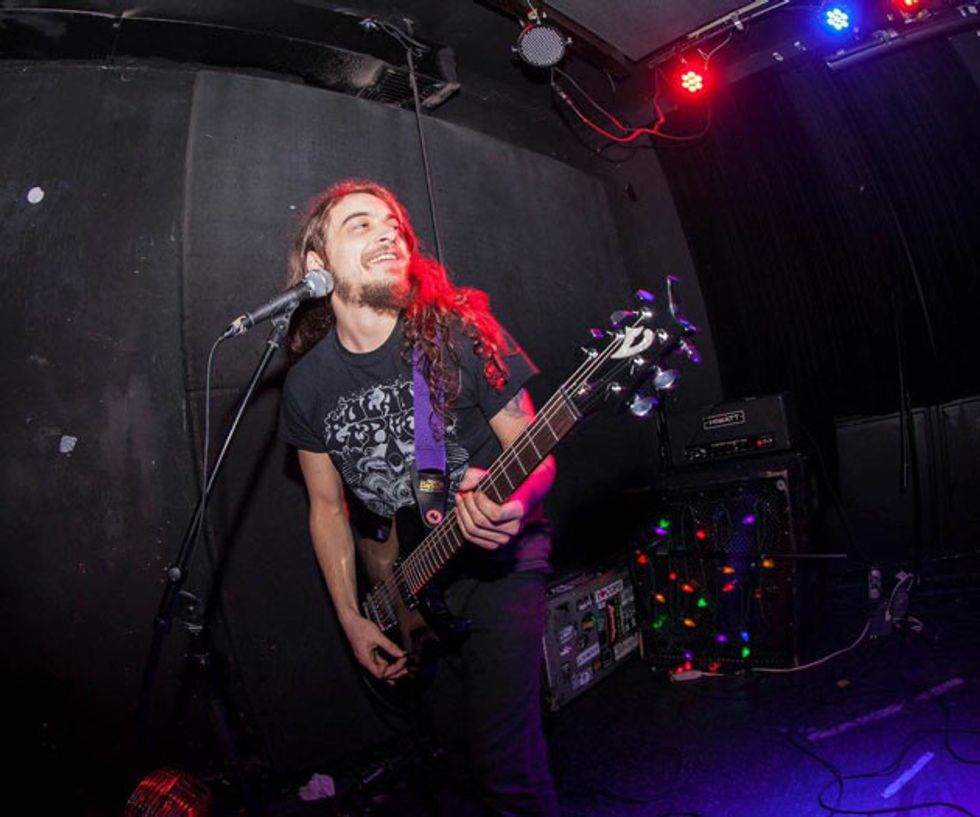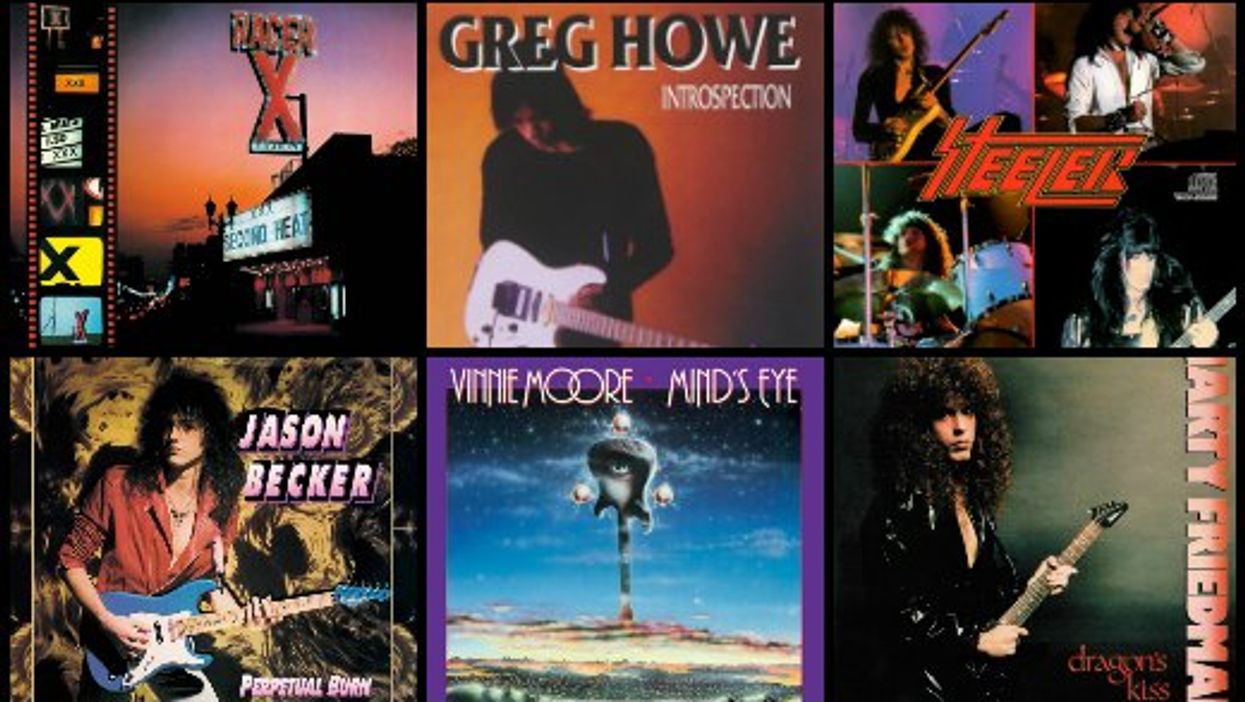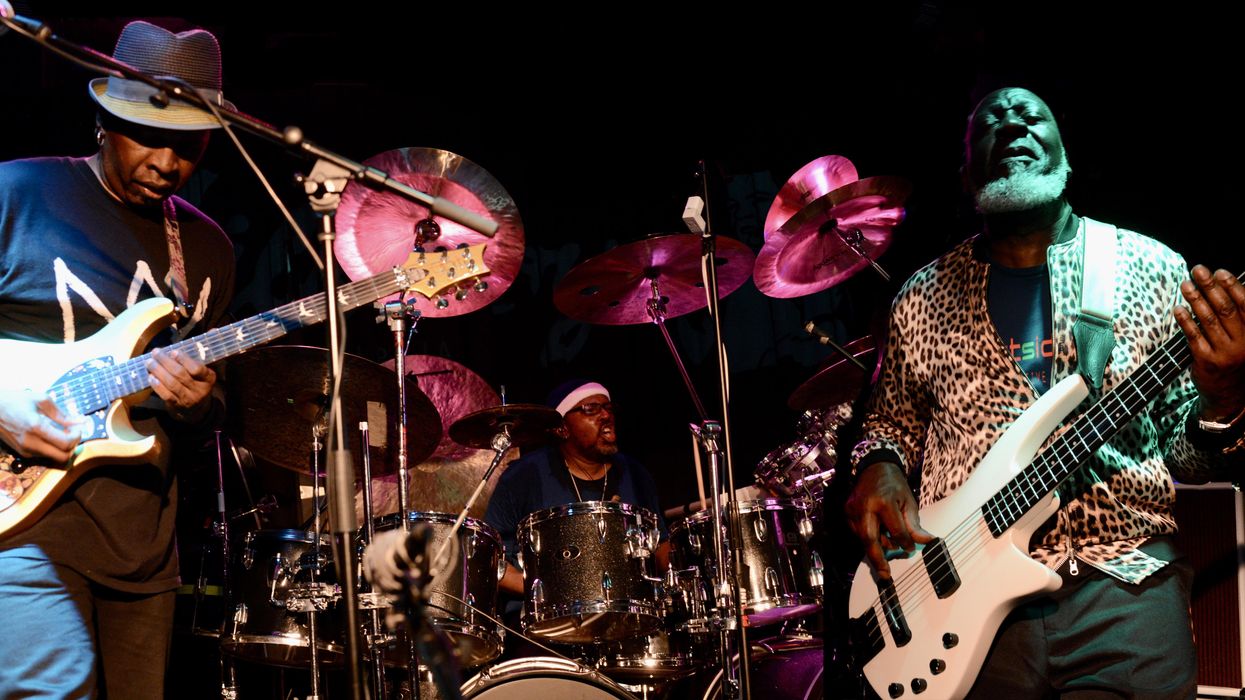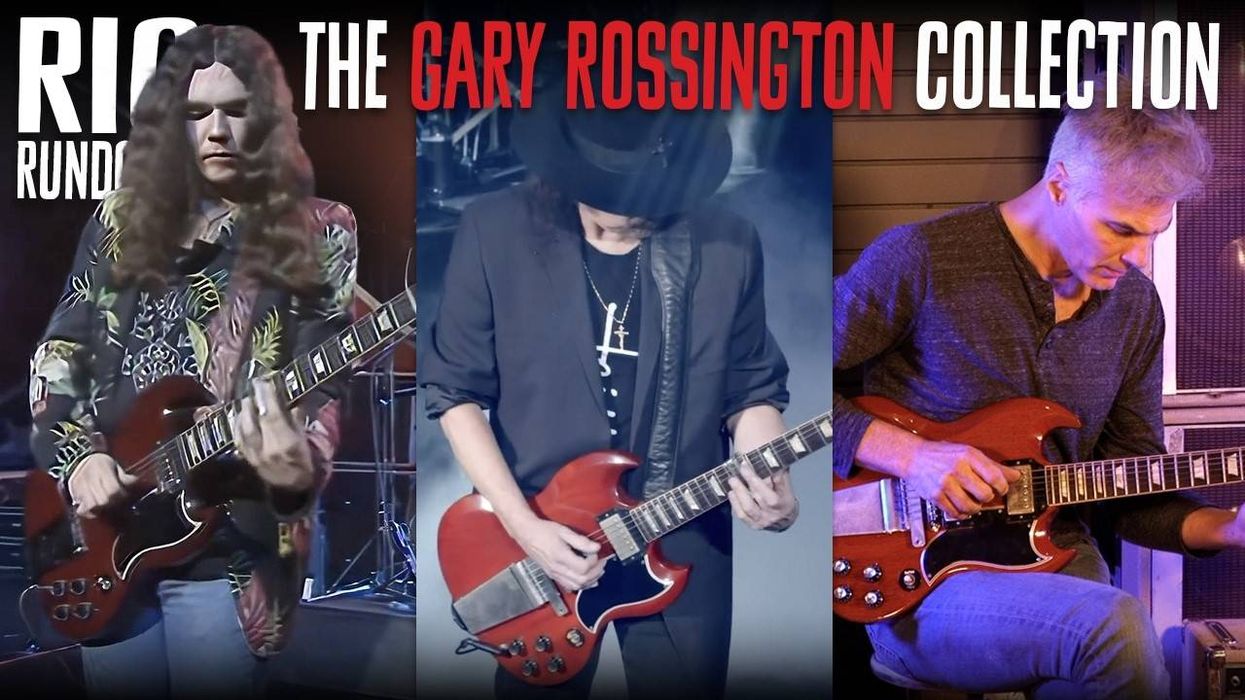Unbridled turbulence. Dexterous metal riffing. Soulful vocals over layers of melodies and shifting rhythms. Moon Tooth’s unique beast of a sound is forged from seemingly disparate elements, and the quartet unleashes it with the kind of intensity and surgical accuracy typically reserved for extreme metal bands.
Based in Long Island, New York, Moon Tooth is steeped in the essential fearlessness at the heart of prog-rock, and their debut LP, Chromaparagon, feels like an epic journey through countless sonic realms. But not once over the course of the album’s 12 tracks do the dramatic stylistic shifts seem like a distracting party trick. Instead, they simply underscore Moon Tooth’s single mission: to play music it describes as “aggressive progressive.” While the band’s genre hopping is certainly a part of Chromaparagon’s allure, perhaps the most impressive thing about the album is just how cohesively these various sonic worlds fit together.
Chiefly responsible for creating and commanding Moon Tooth’s controlled chaos is fleet-fingered guitarist, songwriter, and occasional vocalist Nick Lee. A virtuosic shredder with a flair for the off-kilter, Lee keeps his impressive fretwork at the center of Moon Tooth’s musical maelstroms. We spoke with him about the process of fusing the band’s sonic personalities, where he comes from as a player, and how he goes about recreating Moon Tooth’s mammoth sound onstage.
Chromaparagon has an incredible number of musical ideas stuffed into every corner. How do you guys decide where to take a song—and do you ever draw the line or say “no” to an idea?
I don’t think we’ve ever said “no” to a stylistic curveball. This record was written by myself and our drummer, Ray Marte, who is also a killer guitarist. We’d each show up with half-finished riffs or song ideas and then suss them out together. Neither of us ever says “that’s too this or that’s too that.” Previously we’d been in a three-piece together, and the third guy had a problem with a lot of the very heavy things we’d bring in. But Ray and I listen to a lot of death metal and heavier stuff, and that’s an important part of our respective musical identities. This band is very much a reaction to our experience of not being able to express that within our last group. We operate with no boundaries on purpose, and it’s fun!
How do you characterize Moon Tooth’s music to the uninitiated?
The phrase we’ve been using is “aggressive progressive,” but that’s really just because saying you’re in a rock ’n’ roll band doesn’t quite get the point across these days. We’re not trying to be a prog band, really. We totally get that there’s an element of prog in what we do, but to me we’re just a rock band in the purest sense of that term—we just happen to push the envelope of what we can do musically and push each other to do crazier shit.
But there’s still a lot of classic prog in your music, especially on an instrumental like “Bats in the Attic”—which sounds like you’re quoting a bit of Yes.
Oh yeah, the “Heart of the Sunrise” riff. That was totally subconscious, but we laugh about it all the time because we listen to that Yes record a lot and always go, “Oh shit, we kind of stole that riff!” But it just happened that way—we absolutely didn’t write it as an homage or anything.
That said, we don’t operate the way a lot of contemporary prog bands work, and there’s never been an effort to write something specifically to impress other musicians. Ray and I have been playing together for so many years at this point that we’ve developed this friendly competition of who can come up with the crazier riff, but I want to write stuff that is memorable, rather than just impressive.
The album has some very dramatic dynamic shifts, including some surprising death-metal-tinged passages.
Yeah, we love blast beats. Ray and I grew up on Cryptopsy and Cannibal Corpse, and we still listen to a ton of that shit! I primarily listen to music that’s far heavier than what Moon Tooth does, but this band is a product of all of our influences and I think that shows. Pantera was a very big deal for me and Ray, especially things like how tight they could lock in live. We really aspire to pull off that kind of pocket and groove within our own thing.

Moon Tooth’s debut album, Chromaparagon, reflects the band’s diverse stylistic interests. “We totally get that there’s an element of prog in what we do,” says guitarist Nick Lee, “but to me we’re just a rock band in the purest sense of that term—we just happen to push the envelope of what we can do musically and push each other to do crazier shit.”
Tell us a bit about where you come from as a guitarist.
My dad is a huge Black Sabbath and Motörhead fan, and I always had hard rock playing in the house. My parents’ friends and my aunts and uncles always had cover bands, so I was always surrounded by it. I heard Metallica for the first time when I was 6 and that changed everything. The darkness of it really hit me hard, and I just wanted to be James Hetfield when I was a kid. Once that started, I had the typical adventure and search through heavy metal. I discovered Dimebag and Pantera next, and eventually I got into Brent Hinds from Mastodon. His style, with the hybrid picking stuff, really opened up my musical world. I got into Chet Atkins and Leo Kottke through Brent Hinds’ playing—he changed the game for me a lot. The hybrid-picking and pull-off style of lead playing that comes from country music has become a big part of what I do. I really like to steal the best parts of country guitar playing and infuse my riffs with it.
I don’t really write simple songs naturally—most of it’s pretty physically demanding on me and I like that. For me, playing music is a very therapeutic, cathartic thing. I’m always trying to force some evil out onto the guitar, so the riffs I write tend to be very physical and busy as a byproduct of that. I’m also really into building a basic groundwork for riffs and expanding on that as a writing tool. A lot of the stuff I write for Moon Tooth begins as something simple in its infancy, and then I’ll add fills and ideas until it evolves into something unique.
You play like someone with a serious musical education.
I studied for 10 years under Mike Flyntz, who is best known as the guitarist for the band Riot—a classic New York metal band that has been around since the late ’70s, and which I also play in these days. Mike taught me everything I know. I took music theory in high school for a few years and I did a semester at college as a performance major, but I hated it at the time. I’d probably feel different about it now, but when I was 18 I didn’t want the guitar to be homework. So I’m educated enough to express what I want to, but I’m not like a deep theory head or anything, and I don’t consider it that much when I write.
How does Moon Tooth go about structuring songs and making these wild changes flow so well?
It’s pretty natural, honestly. A lot of those things just come together on their own, but a lot of the time we just add a little flair between the changes. It’s mostly organic.
Once Lee discovered his Vigier G.V. Rock 6-string, life onstage improved immediately. “Because Vigier guitars have carbon-fiber truss rods,” he explains, “they have the most incredible tuning stability, which really helps when you’re switching tunings as often and drastically as I do. I used to spend a lot of time onstage having to fine-tune things before we could hit the song, but with the Vigier I just switch the tuning and I’m ready to roll.” Photo by Sean Ageman
There are a ton of guitar tracks on Chromaparagon, but you’re the sole axe-man live. How do you approach recreating all that sound onstage?
I use a lot of pedals, and live I run a ’74 Hiwatt. It’s loud as fuck, so I’m never worried about being loud enough or making all the noise I need to. For certain things, like the harmonies and double-tracked stuff, we just accept that it’s a different animal live, although I do use a lot of octaves and delays to fill things in sonically. We’re also very physical onstage—we do a lot of running around and climbing things, and we try really hard to put on a show beyond just the sonic experience.
The vocals work in a really cohesive way with your athletic guitar playing. As a band that writes around riffs, are you particularly conscious about how the vocals are going to work with parts when you pen them?
It’s really an evolving thing for us. I wrote all the vocals and arrangements for the Freaks EP we put out prior to Chromaparagon, but that album came together before we were really a band in earnest, and when John [Carbone] sang those parts, they were intact when we brought him in.
With this record, it was really time to let John do his thing and we had to do a lot of demoing to get it together. John’s a constant creator and always has new ideas and is always writing lyrics, and he’s the kind of singer who can fit his stuff into everything. The vocals on this album are much less of an afterthought, where we fit vocals over a completed song. The few songs I sing—like “Little Witch” and any of the screaming stuff—are extremely simple for a reason.
Let’s talk gear. What do you use onstage, and is it similar to what you used on the album?
I had been using a Reverend Sensei with these great [Joe Naylor] Railhammer pickups that I love. Before that I’d been a Les Paul guy, but I kept breaking the headstock on my old one. The last time it happened, it cost me $400 to repair and I just couldn’t do it anymore.
Nick Lee’s Gear
Guitars2016 Vigier G.V. Rock w/ Amber pickups
Amps
1974 Hiwatt DR103
Krank Revolution 4x12 w/ Eminence speakers
Effects
Fuzzrocious Demon
Fuzzrocious custom boost
Wampler Ego
Electro-Harmonix Pitch Fork
Electro-Harmonix Holy Grail
Boss Harmonist w/ Roland EV-5 exp. pedal
Ernie Ball VP Jr
MXR Phase 90
Danelectro Back Talk Reverse Delay
MXR Carbon Copy
DigiTech DigiDelay
Dunlop DB01 Cry Baby from Hell
Boss tuner
Strings and Picks
Ernie Ball custom string sets (.011, .014, .020, .032, .044, .056)
Dunlop Tortex .88 mm picks<
Planet Waves cables
Very recently I got an endorsement with Vigier guitars, and that’s been huge for me. Because they have carbon-fiber truss rods, they have the most incredible tuning stability, which really helps when you’re switching tunings as often and drastically as I do. I’m in E standard primarily, but we have songs in open C, and we also have songs where I drop the lowest string down to A or G. And we do a ton of weird tuning stuff, like on “Chroma”—one of Ray’s songs—which is in a tuning we made up: F–A–C–G–A–C. I used to spend a lot of time onstage having to fine-tune things before we could hit the song, but with the Vigier I just switch the tuning and I’m ready to roll.
Which model of Vigier are you using?
I’m using their G.V. Rock model.
How about amps?
On the record I used a 1974 Hiwatt DR103 that we combined with a Peavey 5150 to get a more modern metal chunk. But we also used a vintage Fender Deluxe, and I brought in a ’60s Fender Vibro Champ, which we used for a lot of the cleans. That sounds huge when it’s miked up the right way.
What cab are you running the Hiwatt through?
I use a Krank 4x12 loaded with Eminence Wizards. It sounds awesome, but it’s just so loud. I’ve been thinking about switching to something smaller, because I can’t really get the goods out of the Hiwatt when I’m running a miked 4x12. If I can’t get the master volume past 2, it’s really not the tone I want. A good attenuator might be the next step. There are times I wish I had something more modern and functional, but when I play a show where I can get the Hiwatt opened up, it just sounds so good that it’s hard to move on.
What pedals are you using to get those big, dirty sounds out of the Hiwatt, which is typically very clean?
My main drive sounds are all courtesy of Fuzzrocious pedals. I mainly use their Demon model, but Ryan [Ratajski] at Fuzzrocious also built me a simple, one-knob clean boost because the Demon is so loud that when I turn it off, my clean is too quiet. That clean boost balances things out. I also use a Wampler compressor, which is on pretty much all the time and helps balance things.
Just the typical stuff. We definitely make sure we hit the songs very hard at rehearsal—even if we’ve been playing a set for a long time. I also do specific warm-ups and stretches before gigs. There will always be parts that are a headache, but between the practice and the amount of shows we play, things stay tight. We tour a lot—we’re on a long U.S. tour with Intronaut right now—and there’s really no substitute for all those hours onstage.
YouTube It
This studio play-through of “Offered Blood” reveals Moon Tooth’s extraordinary instrumental chops.










![Rig Rundown: Russian Circles’ Mike Sullivan [2025]](https://www.premierguitar.com/media-library/youtube.jpg?id=62303631&width=1245&height=700&quality=70&coordinates=0%2C0%2C0%2C0)














![Rig Rundown: AFI [2025]](https://www.premierguitar.com/media-library/youtube.jpg?id=62064741&width=1245&height=700&quality=70&coordinates=0%2C0%2C0%2C0)




















 Zach loves his Sovtek Mig 60 head, which he plays through a cab he built himself at a pipe-organ shop in Denver. Every glue joint is lined with thin leather for maximum air tightness, and it’s stocked with Celestion G12M Greenback speakers.
Zach loves his Sovtek Mig 60 head, which he plays through a cab he built himself at a pipe-organ shop in Denver. Every glue joint is lined with thin leather for maximum air tightness, and it’s stocked with Celestion G12M Greenback speakers.











